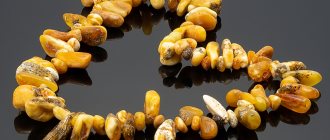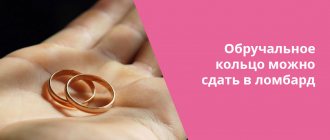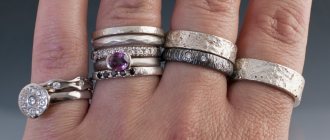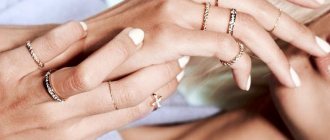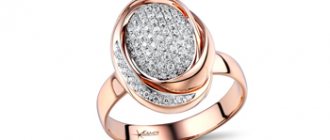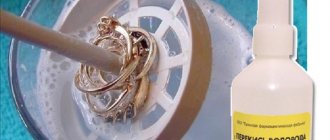Piercing the earlobe with a gun
Technique for ear piercing: “cock” the pistol and “load” the earring into it (the technique of this procedure is described in great detail in the instructions for the pistol).
The gun has a free stroke, during which there is no click. This is necessary to fix the earlobe and bring the tip of the needle earring to the intended puncture point. If everything is ready and the point is at the tip of the needle, we overcome the resistance of the “trigger” and the gun fires. The earring is fastened in the ear. Using a downward movement, remove the gun from the earlobe.
Ear piercing points
Ear piercing points are an important point. Our ears are an important organ, and in addition to the main auditory function, there are others besides external manifestations. The external auricle is the location of a large number of biologically active points that are connected to most organs in the body. I would like to discuss such a topic as ear piercing, the place and choice of point for this, as well as the possible consequences of this action. 98% of women and more than 26% of men now have their ears pierced. It is fashionable, popular and beautiful, and will continue to develop. Let us dwell specifically on the choice of the ear piercing point, and the basic rules and aspects of this procedure. Earlobe piercing is a widespread phenomenon, which in most cases occurs in childhood. There is no need to say that it is safe, harmful, or aesthetically pleasing; here everyone must decide for themselves what is what. The procedure can be done from a medical point of view from the age of seven years, when the auricle has formed and will only increase in size with age, without affecting the internal processes. The ear is a fairly wide area for decoration, and there may be variations in the choice of ear piercing point. The earlobe is most often pierced, because... this area has no hard parts, heals faster and looks good with decoration. An interesting fact is that this is where the acupuncture point responsible for the connection with vision is located. A little higher there is a point associated with the tongue. The remaining biological points are located mostly along the contour of the auricle and partially inside it. You can believe or not believe in the biofield of the human body, but the fact remains that choosing a point for piercing your ears is an extremely important point in the future, especially when there are several holes. Many researchers claim that only the lobe can be pierced, and other areas should not be touched. This issue is quite controversial and requires a separate analysis. In addition to the correct choice, the method and instrument of the operation is no less important. Most often, a special gun is used here, which uses a thin needle to tear the fabric and leave a hole in it. On the one hand, this method is proven and old and gives a well-known result, however, more and more experts are talking about spreading the ear tissue with a needle or point puncture, which undoubtedly affects a smaller area and localizes the effect. It is also important to take into account the person’s absence of diseases such as anemia, eczema and general skin problems. The location of the ear piercing and the method can significantly affect the healing time and survival of the inserted material. Choosing a point for ear piercing is a rather serious issue that should be discussed with a specialist or even a doctor. You should not rush and get a piercing at an early age, and especially not use the edge of the ear, which is represented by cartilage. There is a high probability of disrupting the integrity of the structure and blood circulation of this important organ, as well as having a negative impact on the organs associated with a particular area. Perform the puncture only in a specialized place, using a disposable and disinfected instrument that has passed certification. Take into account the fact that more than 32% of people who have their ears pierced have complications in the form of swelling, suppuration, swelling and slow healing, which is largely determined individually and depends on the general condition of the immune system. Avoid contact with water for the first 4-5 days, as... this greatly contributes to the development of infection and inflammatory processes. Caring for pierced ears is a science. The choice of jewelry should also be thoughtful and focused on gold, silver, surgical steel, which reduces the likelihood of inflammation and complications. Ear piercing points are an important criterion to consider when installing jewelry. Finally, watch the ear piercing video.
In contact with
LiveJournal
Contraindications for ear piercing
The procedure is contraindicated if you have:
- chronic diseases (diabetes mellitus, hepatitis, etc.)
- skin diseases
- severe allergies
- weakened immune system
- poor wound healing
- infection
- recent vaccination
- bad feeling
- predisposition to the formation of keloid scars
photo Ear piercing
Studex ear piercing guns and earrings
Today, one of the highest quality, safest and most reliable ear piercing instruments are the Studex systems, made in America. What is unique about this equipment? STUDEX is one of the largest manufacturers of professional ear piercing equipment in the world. Over many years of work, the company’s specialists have managed to develop reliable and high-quality instruments for safe ear piercing. For each Studex system, sterile Studex needle earrings are produced, with a specially sharpened pin, which allows you to make a puncture quickly and almost painlessly. The Stadex brand uses hypoallergenic medical steel as the material for earrings. In addition to product quality, the company pays special attention to the affordability of prices for its jewelry. In order not to increase the cost of jewelry, Studex needle earrings use not natural, but artificial stones and pearls, as well as crystal and Swarovski crystals.
photo Ear piercing. Studex needle earrings
As for the assortment, the Stadex company regularly updates its collections, surprising fans of its products with spectacular and modern designs. Earrings for ear piercing with the Studex system are available in different shapes, sizes and with different decorations to suit every taste. For small children, for example, you can choose neat needle earrings with multi-colored rolled stones. For older children and adults, jewelry with pearls, crystal, shaped earrings (hearts, flowers, stars) or jewelry with prong fastenings are suitable. In addition, for those who do not like the color of the metal, the company produces gold-plated products.
Cartilage Piercing Care
Medicines for puncture treatment
Let's name proven drugs that help disinfect the puncture site and speed up healing:
- 3% hydrogen peroxide solution;
- Levomekol (ointment against suppuration);
- Chlorhexidine bigluconate (disinfectant solution);
- Baneocin (powder preparation);
- Miramistin (used after cleansing with peroxide, when you need to remove particles of blood and secretions);
- Dioxidin and Octenisept (used strictly as prescribed by the specialist to cope with complications).
We have listed common pharmaceutical medications, but in each case the approach is individual. You just need to follow all the recommendations of your master. A specialist knows better how to treat an ear piercing depending on the characteristics of a particular piercing.
Days style cartilage piercing, short straight barbell with balls
blue tragus style flower piercing and 2 small studs in the lobe, cartilage piercing, colored straight short barbell with balls
Advantages of ear piercing with the STUDEX system
The R993 gun and System 75, developed by the Studex brand, are unique modern tools that allow you to pierce your earlobe with virtually no pain. Also, the undoubted advantages of both Studex systems include:
- Complete sterility.
Both systems fully comply with all requirements and hygienic standards accepted in the world. - Virtually painless ear piercing.
The specially sharpened tip of the earring needle allows you to make a puncture in a split second, significantly reducing pain. - Easy to use.
Preparing the instrument for puncture takes literally a minute. - Safety.
Thanks to the special fastening earring system provided in the design, the jewelry will not fall out of the instrument and will be precisely fastened in the right place. A special lock that snaps the clasp into place completely eliminates injury or pinching of the earlobe during a piercing.
photo Guns and Studex earrings for ear piercing
Care for fast healing
Healing of cartilage can last several months and directly depends on compliance with the processing rules.
In order for the wound to heal quickly, it is necessary to care for it throughout the entire rehabilitation period. Care:
- Do not get it wet in the first few days.
- Do not remove the earring until it is completely healed.
- Twice a day and after exposure to dust and dirt, treat the hole with antiseptics: Chlorhexidine, medical alcohol, Miramistin, hydrogen peroxide 3%.
- Wipe the puncture site with an additional antiseptic after sports activities.
- Starting from the second day, pull the jewelry so that the canal can heal properly and the earring does not adhere to the skin. In the first days this is difficult to do, as the hole may swell.
If the wound becomes very painful or festers, seek medical help. An infectious process may develop.
If you are allergic to the alloy from which the product is made, removal and replacement with a hypoallergenic material may be recommended.
How to care for your ears after a piercing
After the piercing procedure, it is very important to ensure proper care of the piercing sites. If all recommendations are carefully followed, the healing process will proceed quickly and without complications. So, what to do after getting your ears pierced:
- To prevent infection, twice a day, morning and evening, it is necessary to treat the puncture sites on both sides with hydrogen peroxide, alcohol or a special Studex healing gel. During disinfection, you need to carefully turn the earrings so that the product gets inside the puncture.
- Four days after the piercing procedure, it is necessary to rotate the earrings at least 2-3 times a day (with previously disinfected hands) to prevent stagnation and inflammation of the ear piercing.
- 1.5-2 months after the piercing, the ears heal and the earrings can be removed. It will be quite difficult to do this the first time. In order to carefully remove the first earrings, you need to hold the “head” of the product with two fingers and slowly pull the fixing clasp back.
- After removing the first earrings, you should not immediately put on jewelry with an “English lock”, so as not to damage the healed channel. At first, you need to choose jewelry with a pin thickness slightly larger than needle earrings. Also, before putting on a new piece of jewelry, you must remember to treat it with alcohol-containing solutions!
Note! It is strictly forbidden to remove needle earrings for at least 1.5-2 months after piercing. During this time, the correct shape of the channel for the earring is formed. If you change jewelry ahead of schedule, you can injure the yet unformed walls of the canal and provoke inflammation. You can wash your hair after ear piercing only after 2-3 days! After piercing, you can visit the pool, sauna or swim in a pond only after at least 2 weeks!
At what age is it best to get your ears pierced?
It is mistakenly believed that the optimal age for ear piercing is from one to two years, since this way the child will not retain memories of the not-so-pleasant procedure. However, doctors still do not recommend piercing the ears of infants to avoid the possibility of infection of the wound, and wait until the child is at least 7 years old. And yet, there is no need to rush: after all, firstly, the wound needs to be constantly treated, and secondly, there is a high chance that during games the child may get injured due to the earring. Therefore, it is best to wait until the child reaches the age when he himself wants to get his ears pierced.
Questions most often asked about ear piercings
Does it hurt to have your ears pierced?
Yes, if we are talking about a puncture with a needle. If the procedure is carried out with a Studex R-993 gun or a Studex 75 system, pain is minimal. Everything will happen very quickly, which is especially important when piercing the ears of small children.
Is it possible to have an allergic reaction to earrings?
Yes, unfortunately, this is possible if the earrings for the first piercing were made of low-quality material. Also, an allergy may occur after changing the first earrings to other jewelry of dubious quality. To prevent such a nuisance from happening, you need to buy only high-quality jewelry made from safe materials, such as hypoallergenic medical steel.
At what age can children have their ears pierced?
It is difficult to give a definite answer to this question. Some experts believe that piercing should be done before a year, others - after 3.5 years. If parents have made this decision, very young children can have their ears pierced with the 75 system even in their sleep, since the procedure is absolutely silent; older children can have their ears pierced with a pistol.
What to do if your ear becomes inflamed after a piercing?
If the piercing was done with sterile Studex earring needles, the risk of inflammation is almost zero. Infection can only occur if the rules and recommendations for caring for the puncture site are not followed or if there is contact with dirty hands. If, immediately after the piercing, aching sensations and slight redness appear, this is a natural reaction of the body to the puncture. With proper care, these symptoms will subside within 24-48 hours. If the inflammation at the puncture site does not go away within a few days, you need to consult a doctor!
Shameful and prestigious
But how changeable the world is! A little over a hundred years will pass, the 16th century will come, and the King of France, Henry III, will walk through the streets of Paris with a whole garland of earrings in his right ear, one of which will have a huge pearl. This is how the artist of the 16th century captured him in his portrait. And there’s nothing to say about the Victorian era. But even in those days, artistic body piercings became the property of only certain groups of enthusiasts: sailors, criminals, advanced aristocrats, people of art seeking new sensations in sex.
The global epidemic of piercing broke out at the end of the twentieth century, and was preceded by “its own Middle Ages,” where piercing was also a marking of the marginalized - hippies, punks, sadomasochists and simply tramps disturbed by rock culture. Normal girls wore piercings only in their earlobes, but boys did not wear them at all, for fear of being branded “blue.”
The piercing craze began when this fad captured show business stars. Madonna with her rings on the cartilaginous plates of her ears and diamonds in the wings of her nose. Naomi Campbell's golden belly button echoed thousands of belly buttons. The heavy metal harness of the Progidi vocalist is not a hindrance to singing. Mel from the Spice Girls has been singing "brilliantly" since the sparkling pier appeared on her tongue.
Today, all these musical mutations - “techno”, “rock” and others have their own signs in piercing. Respectable business women are not far behind, especially those whose careers in politics and business do not allow them to clutter their faces with iron; they take their toll in intimate piercings: massive gold chains connecting rings in the nipples, rubies, diamonds, emeralds, shimmering on the genitals - everything it affects men like a spicy condiment to strong drink.
However, authorities in different countries are wary of piercing, to put it mildly. In France and Switzerland, piercing is not legalized, although they do not fight it like drugs. On September 16, 2003, the House of Commons of the British Parliament released a bill on body piercing, containing a number of age and other restrictions for those wishing to be pierced. Nature itself supported the strictness of the parliamentarians: shortly before the meeting of the House of Commons, that same summer, news spread across European radio stations: one of the Englishwomen, vacationing in Crete, was struck in the tongue by lightning during a thunderstorm. The cause was a metal tongue pier. They say the girl survived, but left the “tribe” of piercers forever.
Kiss the barbell
If your friend gives you a kiss with a barbell in her tongue or a labret in her lip, then the surgical steel of her pierce is good for both of you from a hygienic point of view. In medicine, surgical steel is used for endoprostheses and, while in the body for many years, does not cause harm to it and does not corrode.
Titanium, platinum, niobium, high quality gold (white), medical plastic - these materials for piercing are also not subject to oxidation, corrosion and have the same good reputation as surgical steel. Gold with copper and other impurities (red, yellow gold), and even more silver are undesirable materials for piercing, especially with fresh punctures.
The influence of oxides, especially silver, on the pierce canal leads to inflammation. Silver and red gold are often used in piercings, but only as decoration for the piercing, without contact with the body.
High-quality polishing of the metal pier, which guarantees against roughness and micro-notches, is not possible for every company. Russian artisans and Chinese traders are not famous for their quality. For the sake of your own health, it is best to get piercings in special salons. Of course, not everyone can afford to gild their belly button with a banana. In this case, the ideal option is piers made of medical plastic: very cheap, light, hygienic, with a wide variety of colors, they can also glow and sparkle in ultraviolet light. In a night bar or discotheque twilight, these magic lights on the lips or tongue give their owner power that is impossible to resist. The apotheosis of this temptation burning in the night can be a kiss with a titanium rod in the tongue (the latest modifications of this pierce, by the way, have a microvibrator). It is better not to use piers made from the fangs of strange animals and exotic wood, because most often it is not known what they are actually made of.
Hygiene rules
As for piercing sites, the navels are the most popular in the summer, and the tongues in the autumn-winter period. The navel is a fairly frequently infected area, and therefore requires particularly careful hygiene (use of bactericidal soap) even after the pierce canal has healed. Ears are pierced at any time of the year; this area is always popular, but it would be a mistake to consider it the safest for infection. As a rule, the puncture heals well on the lobe.
Special mention should be made about intimate piercings. This area is very rich in blood vessels, so drilling it can lead to serious complications - severe bleeding and subsequent infection. In addition, pain may occur when urinating. Sometimes this kind of problem forces you to resort to emergency surgery.
Two weeks after the puncture
The process of scarring and healing of the canal lasts approximately this long.
During this period, you should not play with the new pierce, grab it with your hands, or allow others to do this.
You need to clean the puncture wound every day, using a light antiseptic - rinse it under a warm shower with “green soap”, carefully moving the pierce in the canal. After washing, dry the puncture area with a soft, sterile cloth. If inflammation is present, apply a bandage with antibacterial ointment.
When cleaning the wound, you should not use alcohol, iodine, mercury-based solutions, or hydrogen peroxide (a weak solution of which can be used to stop bleeding during a puncture, but not to heal the canal).
When piercing the tongue, when the tongue swells a little during the first 2-3 days (the tongue heals in 8-10 days), you can rinse your mouth with a light antibacterial solution (although without rinsing, everything usually works out fine). Eliminate or limit smoking.
Avoid alcohol, visiting baths, saunas, swimming pools, and playing sports during the healing period.
Refuseniks
For whom is piercing absolutely contraindicated?
Of course, people with blood diseases. With systemic diseases of internal organs (kidneys, lungs, heart). With skin diseases (psoriasis, furunculosis, eczema). A common chronic disease such as diabetes is also a contraindication. Decreased immunity and slow healing are also contraindications for piercing. People with mental pathologies, as well as drug addicts and alcoholics should not perform punctures.
A question about the presence of an allergy to metals is required: if there is an allergic reaction, then piercing is not indicated.
Nulliparous women planning motherhood should be aware that nipple piercings can cause serious problems when feeding a child. Therefore, during pregnancy, it is urgent to get rid of nipple rings so that the nipples have time to heal by the time of feeding.
glossary
piercing - body punctures (from the English body piercing);
gun - a device intended only for piercing the earlobe (the gun is not suitable for more complex body terrain);
studs - special piers with which the pistol is loaded;
piercings - earrings for piercing (below is a list of their traditional forms);
a ring with a bead (ball close ring) is the most popular pierce, worn on almost any part of the body where a skin fold can be collected;
circular - a horseshoe-shaped pier, with two beads at the ends;
dumbbells and barbells - piers shaped like sports equipment of the same name;
nostril - nostril screw, special pier for the wing of the nose;
labret - a pier, named after its inventor, most often used on the lower lip;
bananas - piers, shaped like the fruit of this name, are often worn on the navel.
Preparing for a puncture
You can get your ears pierced correctly in different places in specialized salons. It is important to properly prepare for the procedure. It is advisable to make an appointment for piercing in the first half of the day - after sleep, the body is rested, energy and vital resources are at their peak. For breakfast, experts recommend eating something high in calories. This will give you an extra boost of energy.
It's important to get enough sleep. In the morning, after waking up, a person should not feel overwhelmed. You must stop drinking alcohol 48-72 hours before the expected procedure. Ethyl alcohol present in such drinks slows down the blood clotting process.
Immediately after waking up, you need to thoroughly clean the auricle and ear canal. The easiest way to do this is with a cotton swab dipped in warm water. Any medications that negatively affect the blood clotting process should be stopped 7-10 days before the intended procedure. Most medications in this category have many side effects, one of which is bleeding.
If the puncture is done in the cold season, then you need to dress as warmly as possible. Warmth must be retained in damaged tissues. It is recommended to cover your ears with a hat.
Don't be shy to ask questions to the master. The client has the right to be present in the office during the sterilization of instruments.


